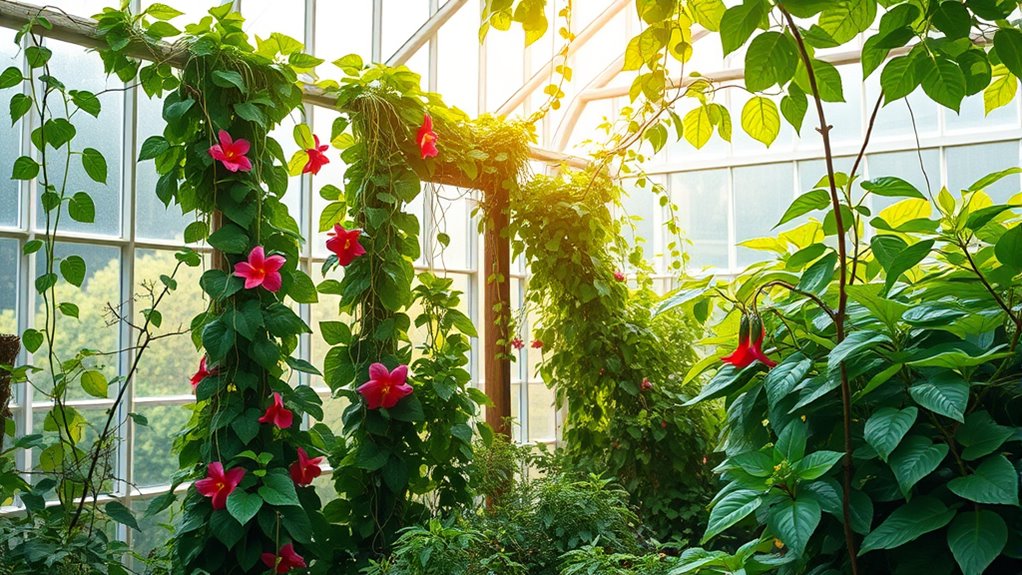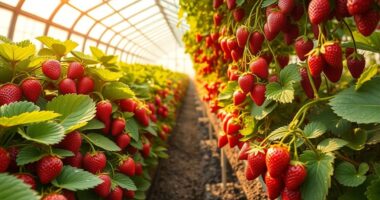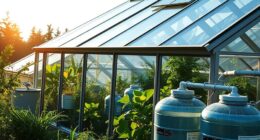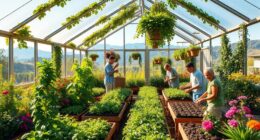Growing vines and climbers in your greenhouse can transform your space. You can choose from various options like Akebia and Wisteria, each bringing unique beauty and benefits. These plants attach themselves using different mechanisms like tendrils or aerial roots, so it’s important to provide sturdy support structures like trellises. Climbing plants also improve air quality and create vibrant habitats. With proper training and maintenance, they thrive beautifully. Discover even more ways to elevate your greenhouse with these incredible plants.
Key Takeaways
- Choose fast-growing climbing plants like Akebia and Grapevines for a fruitful greenhouse garden.
- Utilize trellises and other support structures to maximize vertical space and plant health.
- Implement regular pruning in early spring to maintain vitality and shape of vines.
- Ensure proper securing methods, like ties or rubber bands, until vines are established.
- Monitor for pests and manage overgrowth to promote a thriving greenhouse environment.
Types of Climbing Plants for Your Greenhouse

When you’re looking to enhance your greenhouse, selecting the right climbing plants can make a significant difference.
Consider the Akebia, or Chocolate Vine, which grows quickly and even produces edible fruit. For fragrant blooms, Star Jasmine is an evergreen choice.
If you’re after dramatic visuals, Wisteria sinensis showcases long, cascading flowers that can transform your space. Grapevines not only yield delicious fruit but also provide ample shade, making them ideal for greenhouses.
Clematis offers a stunning array of flowering colors, perfect for adding vibrancy.
Don’t overlook fast-growing options like Morning Glory and Honeysuckle, which can quickly cover trellises and add charm to your greenhouse environment.
Each of these plants brings unique benefits to your garden, contributing to the overall health of your greenhouse ecosystem.
Climbing Mechanisms: How Vines Attach
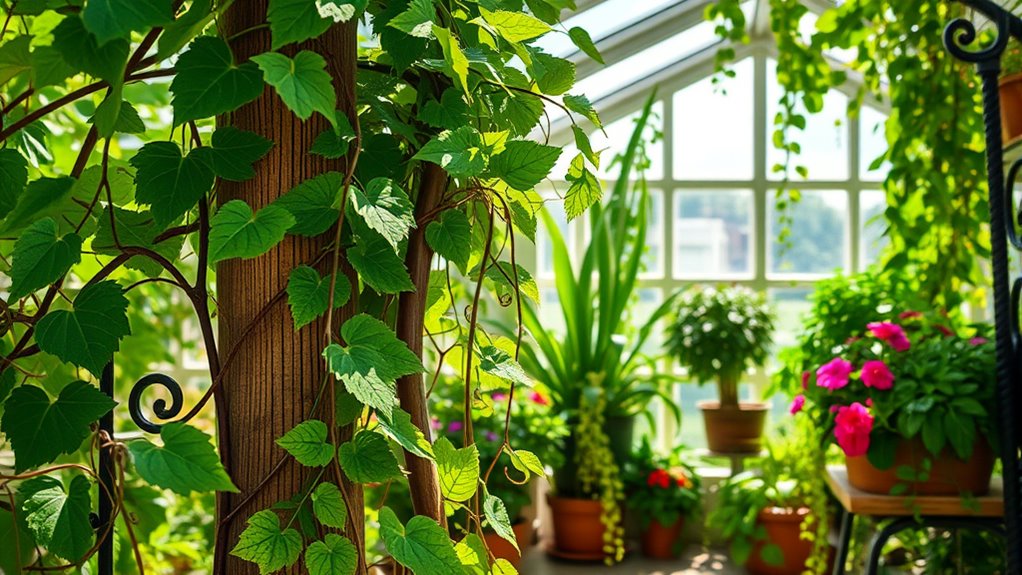
Climbing plants not only add beauty to your greenhouse but also employ fascinating mechanisms to attach themselves to supports.
Vines use thigmotropism to sense surfaces and wrap around them. Tendrils, which are modified leaves or stems, coil around thin supports, while twining stems, like those of honeysuckle, spiral around structures in either a clockwise or counterclockwise direction.
Aerial roots, found in plants like English ivy, cling to rough surfaces, offering strong support. Some vines, such as Virginia creeper, utilize adhesive disks to stick to smooth surfaces quickly.
Each climbing mechanism has its advantages, allowing plants to reach sunlight, avoid herbivores, and establish themselves effectively in your greenhouse environment.
Support Structures for Optimal Growth
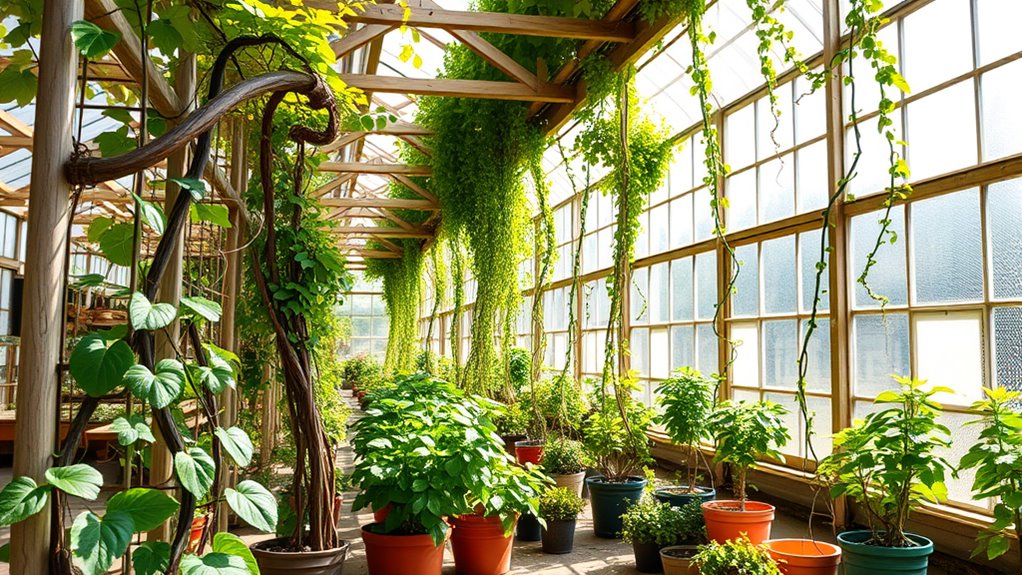
Support structures are essential for maximizing the growth potential of climbing plants in your greenhouse. Trellises offer a versatile latticework for vines, while fences can create a cohesive look without extra costs.
Pergolas and arbors enhance your landscape’s beauty, supporting vines elegantly. Cages, though typically for bushy plants, can be adapted for climbers.
Choose durable materials like treated wood, PVC, or galvanized steel for longevity. These structures improve air circulation and sunlight exposure, promoting healthier plants and better fruit quality.
Opt for treated wood, PVC, or galvanized steel to ensure durable support structures that enhance air circulation and sunlight for thriving plants.
Custom solutions and adjustable systems can meet your specific needs. Regular maintenance, like pruning and proper tie management, ensures your support structures remain effective and your vines thrive beautifully in the greenhouse.
Environmental Considerations for Climbing Plants
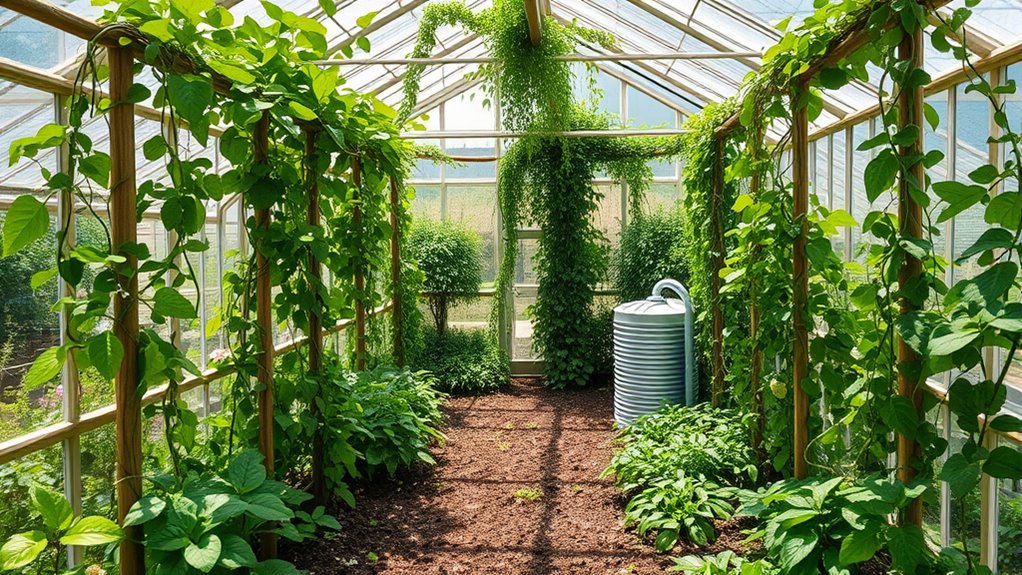
Maximizing the growth of climbing plants not only enhances your greenhouse but also brings significant environmental benefits.
These plants act as natural filters, capturing particulate matter and binding CO2, which improves air quality. By increasing air moisture, they help regulate urban microclimates, making your surroundings more pleasant.
Climbing plants also lower temperatures during hot summers through evaporation and carbon fixation, contributing to cooler walls and air. This cooling effect minimizes dust and smog formation, promoting cleaner air.
Furthermore, climbing plants enhance urban aesthetics without occupying valuable ground space, supporting biodiversity by creating unique vertical habitats.
Incorporating these plants into your greenhouse can significantly contribute to a healthier, more sustainable environment.
Training and Maintenance Techniques

Training and maintaining climbing plants in your greenhouse is essential for their health and aesthetic appeal.
Start by choosing the right support—trellises work well for twining and tendril vines, while poles and fences can accommodate various climbers. Use ties, rubber bands, or floral wire to secure vines temporarily, ensuring they’re not too tight.
Regular pruning is crucial; do this in early spring before flowering to shape growth and promote vitality. Keep an eye on vine direction and adjust supports as needed.
If you notice overgrowth or signs of pests, prune back or inspect regularly. Lastly, remove temporary supports once your vines have firmly attached themselves, allowing them to thrive in their new environment. Additionally, ensuring proper juice extraction efficiency can promote healthier growth in your greenhouse by providing essential nutrients through homemade organic fertilizers.
Benefits and Uses of Vines in Greenhouse Gardening

After ensuring your climbing plants are well-supported and maintained, it’s time to explore the myriad benefits and uses of vines in greenhouse gardening.
Vines thrive year-round, giving you a continuous supply of flowers and produce. The controlled environment of a greenhouse protects them from harsh weather and pests, while maximizing vertical space—perfect for smaller areas. This approach aligns with the MVP (Minimum Viable Product) strategy, allowing you to test various vine types and their growth in your specific conditions. Additionally, incorporating omega-rich seeds like chia seeds into your greenhouse gardening can enhance the nutritional value of your produce.
You can grow a diverse range of ornamental and edible vines, enhancing beauty and food production. Additionally, vines help purify the air and attract beneficial insects for natural pest control.
Their dense foliage aids thermal regulation and reduces soil erosion. With these advantages, incorporating vines into your greenhouse can boost both aesthetics and productivity. Furthermore, growing edible vines can contribute to a lower risk of chronic diseases, as they are often part of a plant-based diet rich in essential nutrients.
Frequently Asked Questions
How Do I Choose the Right Vine for My Greenhouse Environment?
To choose the right vine for your greenhouse, assess your specific environment first.
Consider temperature and light exposure, as some vines prefer full sun while others tolerate shade. Check your local climate adaptability and ensure proper soil conditions, like drainage and acidity.
Look for disease-resistant varieties suitable for your needs.
Lastly, think about space utilization and support systems, as climbing vines will thrive better with the right care and infrastructure in place.
What Pests Commonly Affect Greenhouse Climbing Plants?
Common pests that affect greenhouse climbing plants include aphids, which suck sap and distort leaves, and whiteflies, known for causing yellowing and transmitting viruses.
You might also encounter thrips, which damage surfaces, and fungus gnats that thrive in moist conditions.
Mites can cause stippling on leaves as they feed.
Regular monitoring and implementing integrated pest management strategies can help you keep these pests in check.
Can I Grow Fruit Vines in a Greenhouse Year-Round?
Ever dreamt of harvesting fresh fruit any time of year? You absolutely can grow fruit vines in a greenhouse year-round!
By controlling temperature and humidity, you create the perfect environment for your vines to thrive. Plus, with reduced pests and diseases, your plants can focus on producing delicious fruit.
Just ensure you manage ventilation and provide adequate support for your climbing vines, and you’ll enjoy bountiful harvests throughout the seasons.
How Much Space Do Climbing Plants Need in a Greenhouse?
When planning for climbing plants in a greenhouse, you’ll need to consider their space requirements.
Larger varieties, like cucumbers, typically need 2–4 square feet each, while compact types can thrive in just 1–2 square feet.
It’s essential to space trellises for easy access and maintenance.
Don’t forget to ensure pathways are clear, as this makes caring for your plants more manageable and keeps them healthy and productive throughout their growth cycle.
Are There Climbing Plants That Produce Edible Flowers?
Yes, there are several climbing plants that produce edible flowers.
For instance, nasturtiums are great because you can eat both the flowers and the leaves, adding a peppery flavor to salads.
Additionally, cowpeas have lovely edible flowers that can enhance your dishes.
You might also enjoy the unique taste of the canary-bird vine’s yellow flowers.
Incorporating these plants into your garden offers both visual appeal and culinary benefits!
Conclusion
Incorporating climbing plants into your greenhouse isn’t just about aesthetics; it’s like adding a living tapestry that breathes life into your space. By choosing the right vines, providing sturdy support, and ensuring the ideal environment, you can create a flourishing ecosystem. With a little training and maintenance, these climbers will reward you with beauty and productivity. So, embrace the vertical potential of your greenhouse and watch your garden reach new heights!
